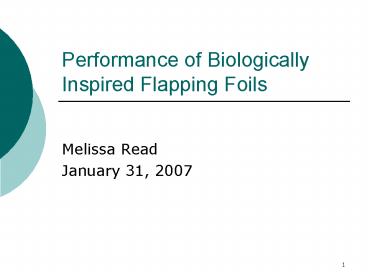Performance of Biologically Inspired Flapping Foils - PowerPoint PPT Presentation
1 / 45
Title:
Performance of Biologically Inspired Flapping Foils
Description:
Performance of Biologically Inspired Flapping Foils – PowerPoint PPT presentation
Number of Views:66
Avg rating:3.0/5.0
Title: Performance of Biologically Inspired Flapping Foils
1
Performance of Biologically Inspired Flapping
Foils
- Melissa Read
- January 31, 2007
2
Motivation
Goal Determine relevant design parameters for
operation of UAVs at low and variable Reynolds
numbers.
3
Achieving Maximum Thrust Three Zone Theory
Images from Anderson
4
Hypothesis and Research Plan
- Hypothesis Peak Thrust Strouhal Number and
Boundaries of Three Zones are a
function of Reynolds Numbers - Research completed
- 1) Confirm Three Zones exist at low Reynolds
number cases - 2) Identify Boundaries of Three Zones for
multiple Reynolds Numbers - 3) Determine Peak Thrust Strouhal Number as a
function of Reynolds number
5
Section 1Confirm Three Zones for Low Re
- 1a) Identify wake structures in previous
literature - Discovered competing theories
- 1b) Design of Fluorescent Dye Visualizations to
determine wake structure - 1c) Execution of Fluorescent Dye Visualizations
- Discussion of Results with regard to Three
Zones - Aside Comparison to each of the two competing
theories identified in previous literature
6
Confirm Three Zones for low Re Previous
Literature
- Two opposing theories
- 1)Von Ellenrieder (right top, right bottom)
- -Fluorescent Dye Visualization
- -Shows secondary
- filamentary arms
- -Does not agree with Three
- Zones
- 2) Blondeaux (bottom)
- -CFD experiment
- -Shows agreement with Three Zones
von Ellenrieder
von Ellenrieder
Blondeaux
Blondeaux
7
Confirm Three Zones for low Re Fluorescent
Dye Visualization
- Experiment Design
- NACA 0030 foil
- c19mm
- h08.5mm
- s57mm
- Re161.5
- St0.2 - 0.4
- ?00 - 20
- F60 - 120
- h(t)h0sin(2pft)
- ?(t)?0sin(2pft F)
8
Confirm Three Zones for low Re Pitching and
Heaving Mechanism
- 80/20 Al Frame
- 600 mm tank (Breeder 40)
- Forward Motion Lead Screw
- Pitching and Heaving Scotch-Yoke Mechanism
9
Confirm Three Zones for low Re Pitching and
Heaving Mechanism
10
Confirm Three Zones for low Re Dye
Application
11
Confirm Three Zones for low Re Experimental
Setup
12
Confirm Three Zones for low Re Dye
Visualization Data
Planform
Wingtip
Isometric
13
Confirm Three Zones for low Re Dye
Visualization Results
?
St0.2
St0.4
Re161.5
14
Confirm Three Zones for low Re Comparison to
CFD, Wingtip
Top Dye Visualizations Bottom Blondeaux CFD
15
Confirm Three Zones for low Re Comparison to
CFD, Planform
Top Dye Visualizations Bottom Blondeaux CFD
16
Confirm Three Zones for low Re Comparison to
CFD, Isometric
Top Dye Visualizations Bottom Blondeaux CFD
17
Confirm Three Zones for low ReResults of Dye
Visualizations
- Confirmation of zones 1 and 2
- Dye unable to operate in Zone 3
- Data confirmed by Blondeaux CFD
- Questions raised about the effect of the dye
- PIV needed to further verify results
18
Section 2Identifying Boundaries of Three Zones
- 2a) Discussion of Particle Image Velocimetry
- 2b) Verification of Fluorescent Dye Visualization
results - 2c) Qualitative Results of PIV Three Zones
Boundary Locations
19
Identify Boundaries of Three Zones Particle
Image Velocimetry
20
Identify Boundaries of Three Zones Particle
Image Velocimetry
21
Identify Boundaries of Three Zones Comparison
to Blondeaux
Top PIV results Bottom Blondeaux CFD
22
Identify Boundaries of Three Zones Results
Re161.5
23
Identify Boundaries of Three Zones Results
Re750
24
Identify Boundaries of Three Zones Results
Re1000
25
Identify Boundaries of Three Zones Results
26
Section 3Determine StPT as a function of Re
- 3a) Calculating thrust using a control volume
method - 3b) Results
- 3c) Discussion of how these results fit in with
prior results and trends
27
Determine StPT as a function of ReControl
Volume Method
U
28
Determine StPT as a function of ReExperimental
Results
29
Determine StPT as a function of ReExperimental
Data
30
Determine StPT as a function of ReExperimental
DataAnderson Data
31
Determine StPT as a function of ReExperimental
DataFish Data
32
Determine StPT as a function of ReTrends
33
Conclusions
- Three Zones Exist for Re 102105
- Boundaries of Three Zones Shift to lower
Strouhal Numbers as Reynolds Number increases - Peak Thrust Strouhal number decreases as Reynolds
number increases - More data needed to determine exact relationship
between Peak Thrust Strouhal number and Reynolds
number
34
Acknowledgements
- Professor Alexandra Techet
- Cha Ling OConnell, Matthew Krueger, David Tobias
- Experimental Hydrodynamics Group, including Tadd
Truscott, Brendan Epps, and Matthew Weldon
35
Experimental Parameters
36
Fish Tail Motion
37
Velocity Profiles Re161.5
St0.2 St1.1
St1.5
38
Velocity Profiles Re750
St0.2 St0.5
St1.1
39
Velocity Profiles Re1000
St0.2 St0.5
St0.8
40
Dye Selection
Freymouth, 1989
Read, 2006
Von Ellenrieder, 2003
Read, 2006
41
Flapping Foil Mechanism
42
Dye Visualization Experiment Considerations
- Smooth Mechanism
- Separate heave and pitch motors (Von Ellenrieder)
- Scotch Yoke Style Mechanism (Anderson)
- Achieving Constant Forward Velocity
- Tow Tank (Anderson)
- Water Tunnel (Von Ellenrieder)
- Clear, non interfering visualization medium
- Coating (Freymouth)
- Injection (von Ellenrieder)
43
Determining Wake Dynamics at Low Reynolds Numbers
- Fluorescent Dye Visualization
- Shows 3D wake structure in one experiment
- Potentially alters flow by introducing a
different fluid into the boundary layer of the
foil - Particle Image Velocimetry
- Non Interfering vorticity measurement
- Detriments 2D (3D equipment not available)
44
Parameters Used to Vary Ct with Respect to St
45
Parameter Definitions
U
ho
?o
c































